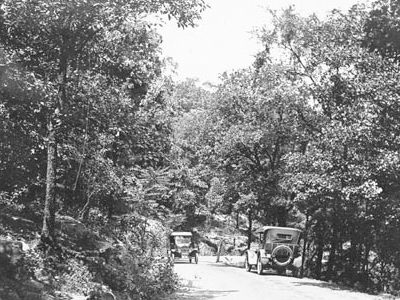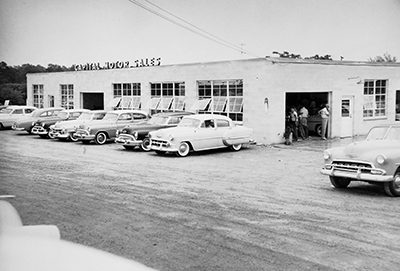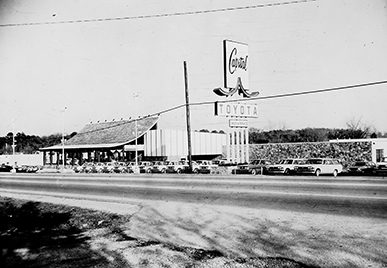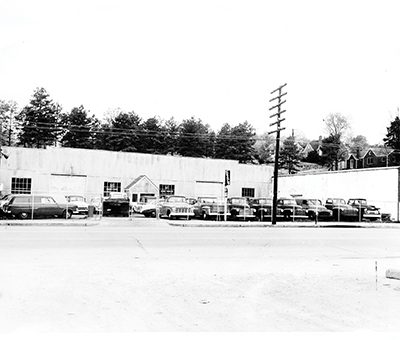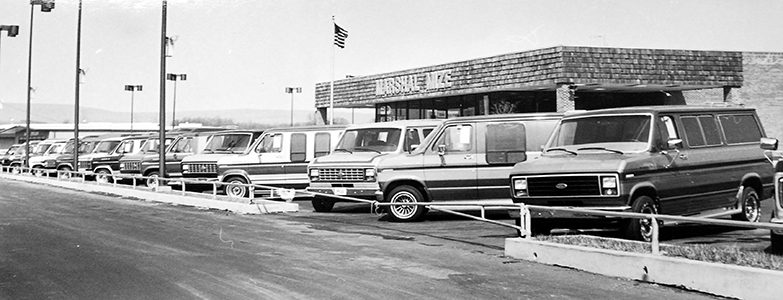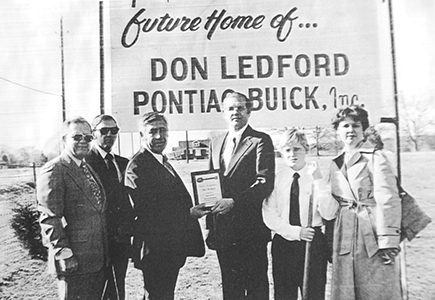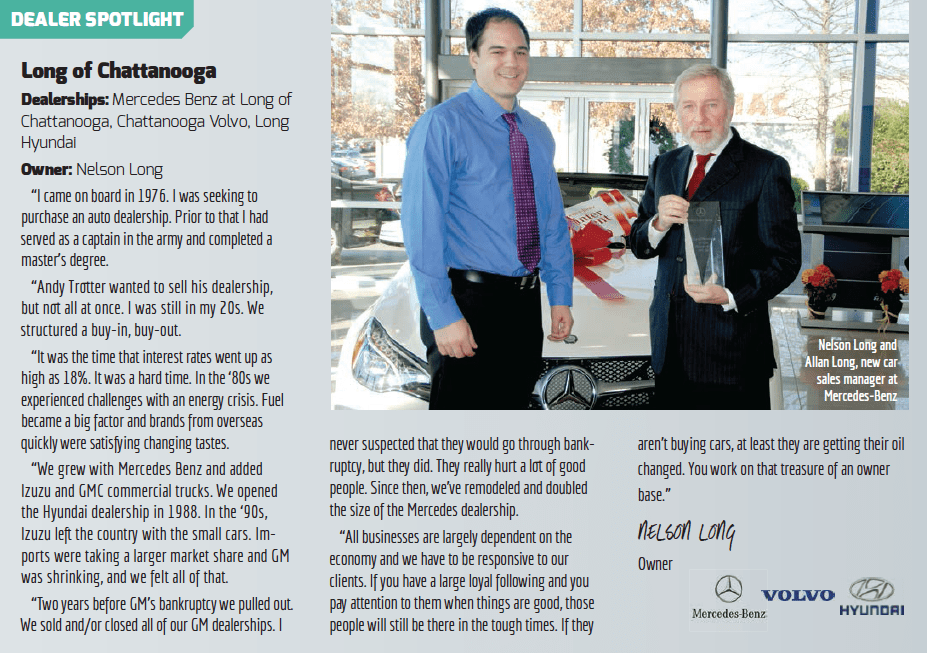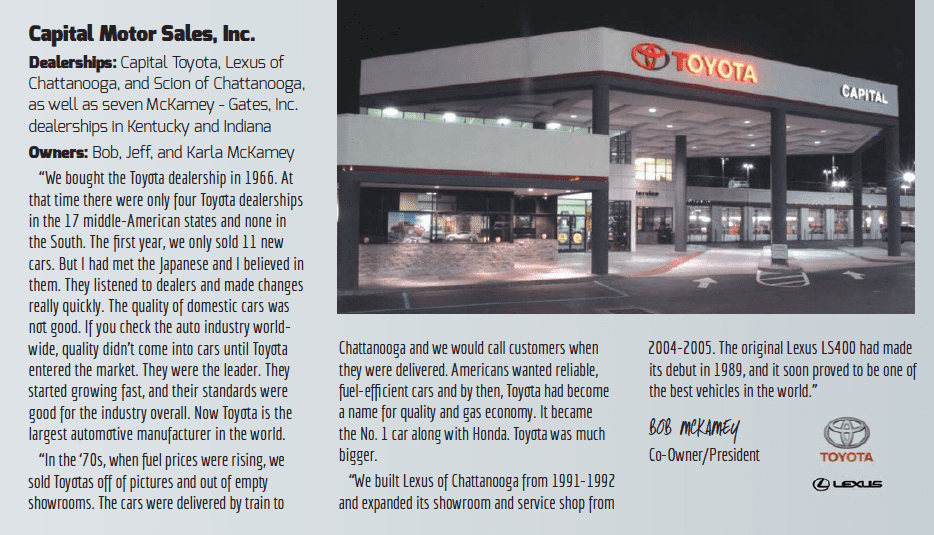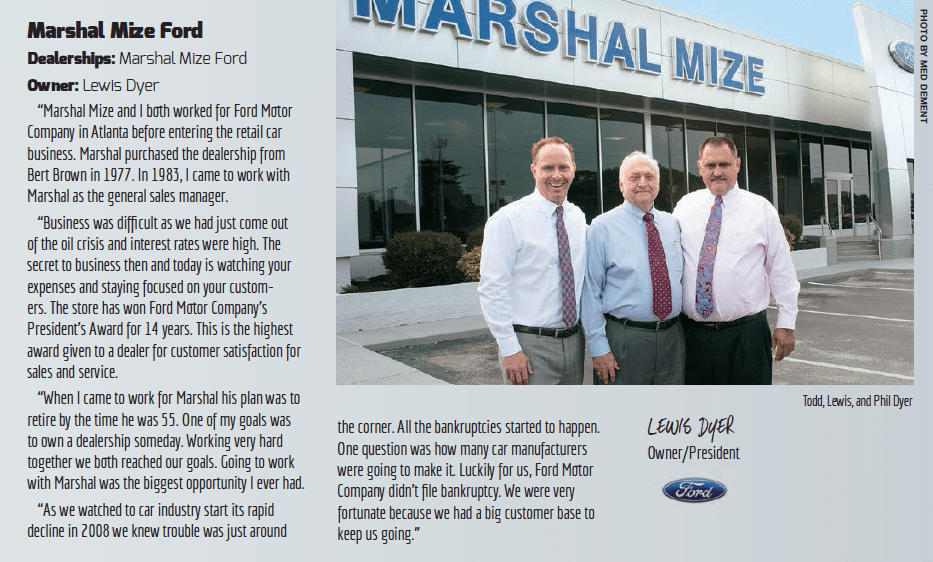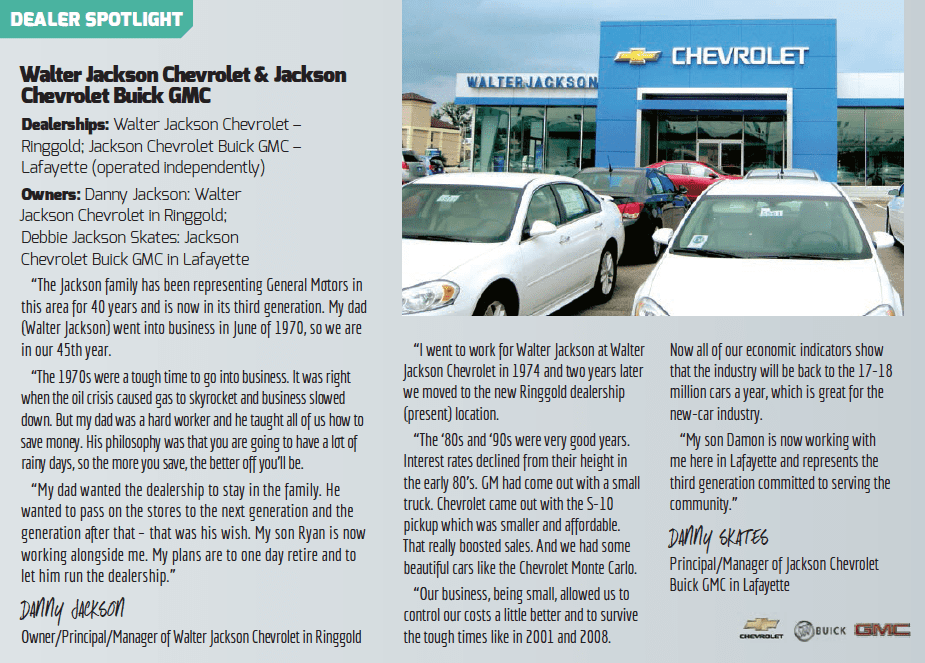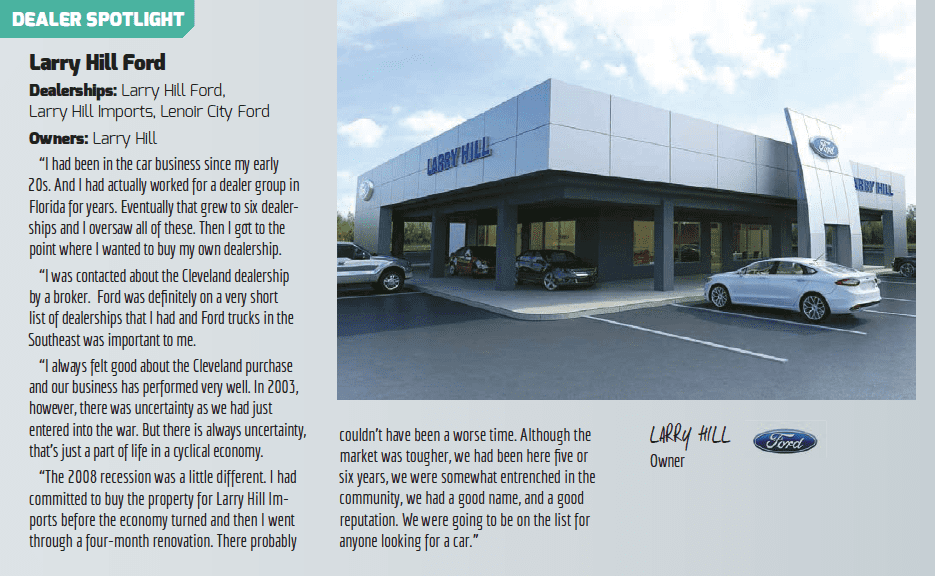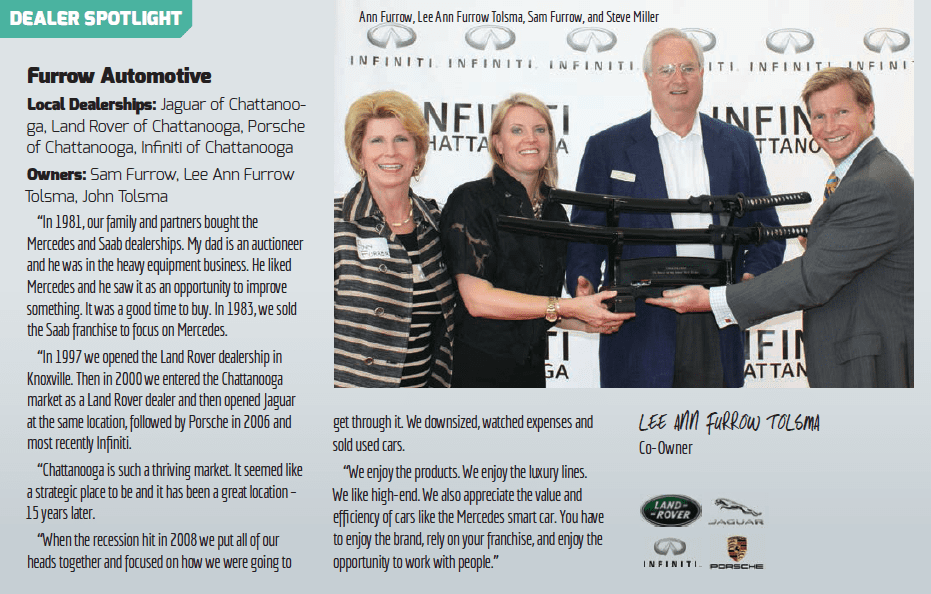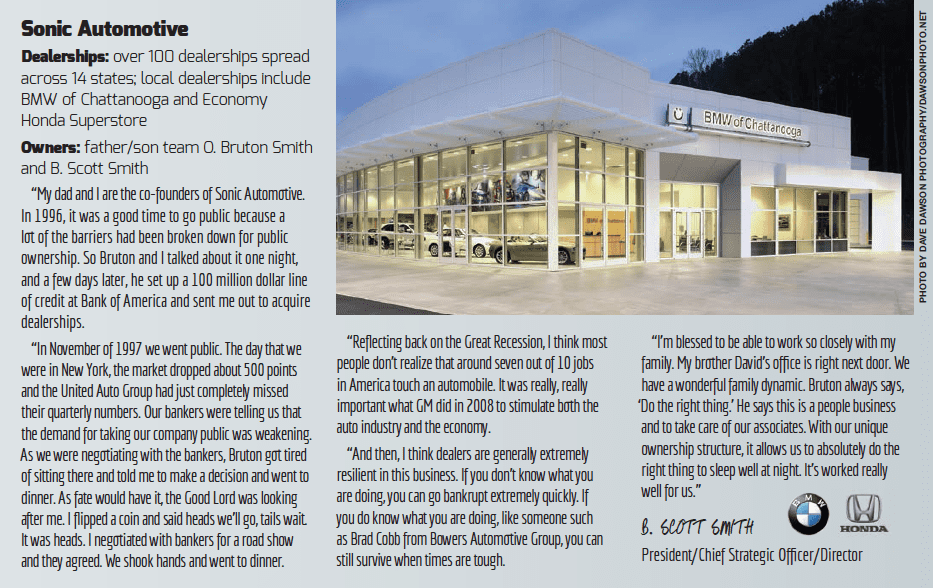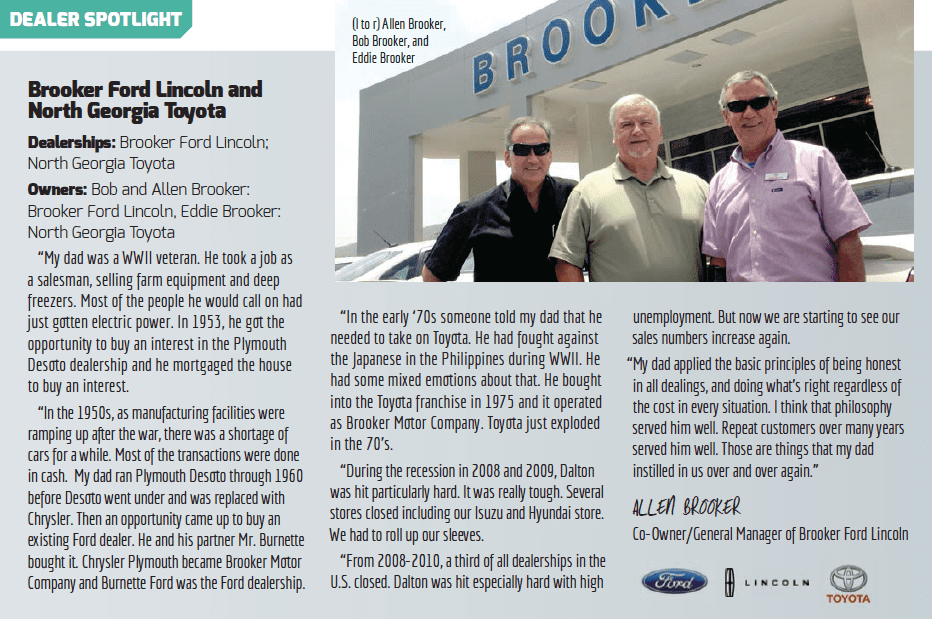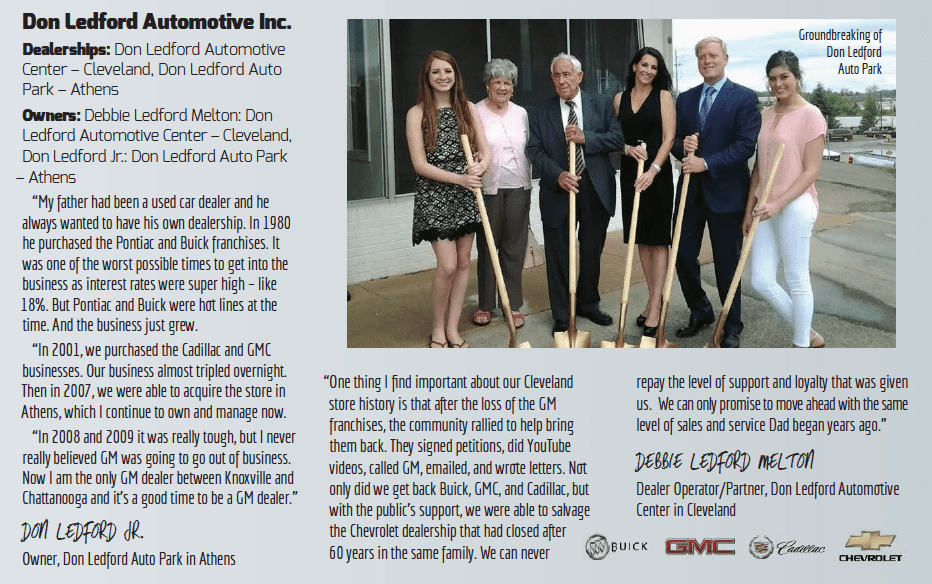By George Christian
Full PDF here.
The automotive industry has arguably been an industry subject to the most change and impacted by more variables for the longest period of time than any other industry. Weathering everything from economic downturns to fluctuating interest rates to swings in consumer confidence, to foreign affairs, global conflicts, and oil embargos, the auto industry has endured periods of darkness, and even complete shutdowns. Yet it has had glory days too – periods in which business has boomed and profits have soared.
Riding these highs and lows now for over a century are independently owned auto dealerships, which across the country and here in the Chattanooga area, have been and continue to be led mostly by families. Many of these families have been a part of the automotive dealer-franchise system for decades, and today continue their long tradition with second, third, or fourth-generation family members at the helm.
Through it all, these dealerships have utilized all of the resources within their control to persevere through some of the most challenging times to enjoy the rewards of hard work, determination, courage, perseverance, and rising consumer spending. What follows is a historical snapshot of the auto industry and the events that have significantly impacted automotive sales and generations of families who have succeeded through the highs and lows of this industry.
1890s-1910s The Auto Hits the Road
Henry Ford began building cars in 1896 and started Ford Motor Company in 1903. The Ford Motor Company improved mass-production with the first conveyor belt-based assembly line in 1913, producing the Model T (which had been introduced in 1908). General Motors Corporation (GM), the company that would soon become the world’s largest automaker, was founded in 1908 by William Durant.
1920s Federal Legislation Paves the Way for Boom Times
In 1916 The Federal Aid Road Act was passed and $75 million was provided to build roads. Shortly thereafter, The Federal Aid Highway Act of 1921 provided additional funding for road construction. By 1924, there were 31,000 miles of paved road in the US. Automobiles were quickly becoming the transportation of choice and everyone was buying cars in the 1920s. Drivers on the road nearly tripled from 8 million in 1920 to 23 million in 1929. Walter Chrysler, formerly president of Buick, took control of the Maxwell Motor Company. In 1925, he reorganized it into Chrysler Corporation. By 1929, 90% of all cars were produced in the U.S. and 75% of the market was controlled by GM, Ford, and Chrysler, later known as the “Big Three.”
The automotive industry has arguably been an industry subject to the most change and impacted by more variables for the longest period of time than any other industry. Weathering everything from economic
downturns to fluctuating interest rates to swings in consumer confidence, to foreign affairs, global conflicts, and oil embargos, the auto industry has endured periods of darkness, and even complete shutdowns. Yet it has had glory days too – periods in which business has boomed and profits have soared.
Riding these highs and lows now for over a century are independently owned auto dealerships, which across the country and here in the Chattanooga area, have been and continue to be led mostly by families. Many of these families have been a part of the automotive dealer-franchise system for decades, and today continue their long tradition with second, third, or fourth-generation family members at the helm.
Through it all, these dealerships have utilized all of the resources within their control to persevere through some of the most challenging times to enjoy the rewards of hard work, determination, courage, perseverance, and rising consumer spending. What follows is a historical snapshot of the auto industry and the events that have significantly impacted automotive sales and generations of families who have succeeded through the highs and lows of this industry.
1930s Great Depression Leads to Consolidation
In October of 1929, everything came to a halt. The stock market crash hit the auto industry hard, just like it did everything else. In one year, U.S. car production dropped from a peak of 5.3 million in 1929 to just under 2.4 million.
The 1930s saw the demise of many auto makers due to the Great Depression, stiff competition from the “Big Three,” and mismanagement. The only major auto companies to survive the Great Depression were General Motors Corporation, Ford Motor Company, Chrysler Corporation, Hudson Motor Car Company, Nash-Kelvinator Corporation, Packard Motor Car Company, Studebaker Corporation, and Crosley Motors. The “Big Three,” enjoyed significant advantages over smaller independent auto companies due to their financial strength, production, and technological innovation.
1940s WWII Auto Manufacturing Halts – Shifts to War Vehicles and Ammo
After the U.S. entered World War II, all domestic passenger automobile productionceased. Factories were converted to produce war vehicles, aircraft, and armaments, a change that ultimately led to greater technological innovations. From 1942-1945, the U.S. auto industry produced 20% of the U.S. equipment used to fight World War II, all of which played a large role in the victory of the allies.
Late 1940s-1950s Production Restarts with Post-War Prosperity
As domestic production started again, it was full speed ahead for the auto industry. With consumer confidence at a new high, gas prices at record lows, and years of savings, demand for cars exploded. From 1940 to 1960, auto ownership in the United States more than doubled from 27.5 million registered vehicles in 1940 to 61.5 million in 1960.
Americans began to view cars as symbols of status and glamour. Cars began to grow in overall size, becoming lower, longer, and wider. Exterior styling was influenced by jets and rockets as the space-age dawned. Rear fins were popular and front bumpers and taillights were designed in the shape of rockets. Chrome plating emerged with two-tone paint. The Chevrolet Corvette (1953) and the Ford Thunderbird (1955) were introduced as personal luxury cars. The auto industry was booming.
1960s The Golden Age Continues
The “Big Three” entered the 1960s at the top of their game, dominating not only domestic sales but sales worldwide.
In 1956, The Federal Highway Act and $33 billion was passed for construction of the Interstate Highway System, a system that would advance the automotive industry and change the American lifestyle forever. Sporty cars emerged with the Ford Mustang in 1964 followed by the Chevrolet Camaro, Pontiac Firebird, Plymouth Barracuda, and others.
As the decade went on, concerns about safety and the effect of car emissions on the environment grew, eventually leading to stricter government regulations. The National Traffic and Motor Vehicle Safety Act of 1966 required shoulder belts for front passengers, front head restraints, energy-absorbing steering columns, ignition-key warning systems, anti-theft steering column/transmission locks, side marker lights and padded interiors. Emission controls were instituted under the Clean Air Act of 1963 and the Vehicle Air Pollution and Control Act of 1965. All three laws forced changes for auto manufacturers that were expensive to implement.

Mountain View Ford; Austin Watson (left), founder of Mtn. View Auto Group, with Don (right) and David Watson, circa 1981
1970s Business Hit Hard: Legislation, Oil, and Changing Consumer Preferences
Federal regulations imposed in the ‘60s forced car manufacturers and consumers alike to adapt. Then auto sales were hit hard and the industry began to change forever with the 1973 Middle East oil embargo. Gas prices skyrocketed and consumer discretionary income declined sharply. Consumers began to turn to smaller more fuel-efficient vehicles offered by foreign auto manufacturers like Honda, Toyota, Nissan, and Volkswagen. Consumer concerns over oil prices and the availability of fuel escalated again in 1979 with oil shortages and an energy crisis associated with political turmoil in Iran. Continued softness in auto sales, shifting consumer preferences for smaller foreign vehicles and new federal standards were turning the world of U.S. automakers upside down. Even more threatening, U.S. automakers were underestimating the threat of foreign automakers.
1980s Caught Off Guard
The next decade began in a recession and worsened behind a savings and loan crisis. Interest rates soared and the automotive industry shed 310,000 jobs, nearly 33% of the entire sector. Interest in small, more efficient cars that had begun in the 70s continued into the ‘80s. The “Big Three” scrambled as they attempted to redesign cars, leading to recalls, poor quality, and lawsuits. Continuing to lose market share to foreign manufacturers, the “Big Three” began to buy into Japanese automakers. The U.S. market was changing quickly and brands of cars being chosen by American consumers were different than those made by Ford, General Motors and Chrysler.
1990s Economic Downturn, Foreign Brands Make Gains
The U.S. began this decade in a recession, which resulted in weak auto sales. Then shortly thereafter, the Persian Gulf War caused oil prices to spike and consumer confidence to decline. However, with the war ending 7 months later, the economy and automakers recovered fairly quickly. From 1996 to the Dot-Com bubble in 2000 the economy and auto sales surged.
Big news for this decade became the continued expansion of multinational automakers in the U.S. and abroad, the explosion of the internet, which made vehicle-related information readily accessible to consumers, and global consumer preferences for less expensive, more reliable, and environmentally-friendly vehicles.
U.S. manufacturers responded by acquiring foreign automakers. GM purchased a controlling interest in Saab and Daewoo Motors, and invested in Subaru and Fiat. They also purchased the Hummer name from AM General. Ford purchased Volvo and Land Rover. GM and Ford also established joint ventures with foreign auto companies.
While American automakers were investing in or buying foreign competitors, foreign automakers continued to establish production facilities in the United States to provide more choices at competitive prices for American consumers.
2000 – 2005 September 11 – Recession – War – Economic Uncertainty – Foreign Investment
The next decade and new century began with a recession in early 2001. Then in September, the entire nation was shaken by the al-Qaeda terrorist attacks leading to the collapse of the World Trade Center towers. Following the 9-11 attacks, the stock market closed for four days, the first time since the Great Depression. The United States launched the War in Afghanistan that same year, followed by the invasion of Iraq in 2003, two overseas actions that would continue to shake consumer
confidence and rattle the U.S. economy. Threats of war continued to drive the Dow Jones Industrial Average down, and on October 9, 2002, it closed down at 7,286.27, having declined 37.8% within two years and 9 months.
With the stock market decline, U.S. automaker pension funds required significant contributions, some of which were financed by raising debt. Meanwhile, foreign competitors aggressively continued to expand manufacturing facilities in the U.S. BMW began production in Spartanburg, South Carolina in 1994 and has since expanded four times. Honda began production in Alabama, Nissan began production in Mississippi, Hyundai began production in Alabama, and Kia began production in Georgia. Toyota also expanded its U.S. operations, starting production in Alabama, Texas, Indiana, and Mississippi. Volkswagen began production at its new facility in Chattanooga in 2011.
2005-2008 Quadruple Whammy: Oil Prices – Financial Crisis – Recession – War
Sales for automobiles in the U.S. continued to be impacted by higher oil prices causing American consumers to seek smaller more fuel-efficient automobiles. Beginning in 2004 prices began to rise with the price for a gallon of gas exceeding $4.00 in 2008.
The bursting of the housing bubble in 2007 and subsequent collapse of the U.S.’s subprime mortgage industry sent the U.S. economy into a downward spiral, eventually triggering the Great Recession and global economic decline in 2008. U.S. unemployment declined steadily from 5% in January of 2008 to an all-time low of 10.1% in October of 2009 – the first time it had been in double digits since 1983.
Weak consumer demand forced automakers to operate below capacity, further weakening them financially. American auto makers that had become heavily dependent upon sales for SUVs and light trucks were badly hurt.
Even worse, highly leveraged American automakers and their finance subsidiaries, which had become increasingly important to overall profitability, could not secure credit.
2008-Present Restructuring & Recovery
Beginning in 2008 and behind the Federal Government’s Troubled Asset Relief Program, over $80 billion in federal funding was provided to troubled automakers. As part of the bailout GM and Chrysler closed numerous production plants, sold off brands and eliminated hundreds of dealerships and thousands of jobs. Family dealerships, some of which had succeeded for decades, lost businesses. Production for vehicles fell to levels not seen since the 1950s. More recently auto industry sales are recovering. In 2013, 15.6 million vehicles were sold, up from a low of 10.9 million sold in 2009. It was the highest volume since 16.7 million recorded in 2007. Most analysts are predicting a solid year for automakers in 2014.






